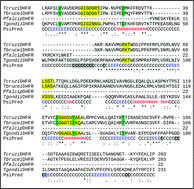Homology modeling of dihydrofolate reductase from T. gondii bonded to antagonists: molecular docking and molecular dynamics simulations†
Abstract
The aim of this work was to solve the structure of the enzyme

Maintenance work is planned from 09:00 BST to 12:00 BST on Saturday 28th September 2024.
During this time the performance of our website may be affected - searches may run slowly, some pages may be temporarily unavailable, and you may be unable to access content. If this happens, please try refreshing your web browser or try waiting two to three minutes before trying again.
We apologise for any inconvenience this might cause and thank you for your patience.
* Corresponding authors
a
State University of Maringá, Av. Colombo 5790, Maringá, PR, Brazil
E-mail:
favseixas@uem.br
Fax: +55 44 36219326
Tel: +55 44 36219300
b
Regional College of Technology, Av. Francisco das Chagas Oliveira 791, São José do Rio Preto, SP, Brazil
Fax: +55 17 33646598
Tel: +55 17 33646589
c
Paranaense University, Pça. Mascarenhas de Moraes, 4282, Umuarama, PR, Brazil
E-mail:
gasparotto@unipar.br
Fax: +55 44 3621-2830
Tel: +55 44 3621-2830
The aim of this work was to solve the structure of the enzyme

 Please wait while we load your content...
Something went wrong. Try again?
Please wait while we load your content...
Something went wrong. Try again?
D. Pacheco Homem, R. Flores, P. Tosqui, T. de Castro Rozada, E. Abicht Basso, A. Gasparotto Junior and F. Augusto Vicente Seixas, Mol. BioSyst., 2013, 9, 1308 DOI: 10.1039/C3MB25530A
To request permission to reproduce material from this article, please go to the Copyright Clearance Center request page.
If you are an author contributing to an RSC publication, you do not need to request permission provided correct acknowledgement is given.
If you are the author of this article, you do not need to request permission to reproduce figures and diagrams provided correct acknowledgement is given. If you want to reproduce the whole article in a third-party publication (excluding your thesis/dissertation for which permission is not required) please go to the Copyright Clearance Center request page.
Read more about how to correctly acknowledge RSC content.
 Fetching data from CrossRef.
Fetching data from CrossRef.
This may take some time to load.
Loading related content
